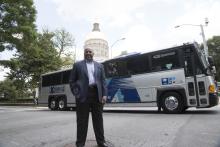President Trump has now completed his first address to the full House and Senate.
Putting aside whether or not you voted for President Trump, putting aside your opinion of how you think President Trump performed at his address, and putting aside whether or not you fundamentally agree with President Trump's approach to domestic and foreign policy, you cannot argue that promising One Trillion Dollars to improve America's decaying infrastructure is a serious amount of money, writes Peter C Vilmos at Burr & Forman.
"For perspective, numerically speaking, One Trillion Dollars looks like this: $1,000,000,000,000.00. Not small potatoes. In fact, it's a larger figure than any known promise for infrastructure improvements on any printed campaign material from either major candidate in the 2016 Presidential election.
And sadly, even that investment would not provide enough funds to upgrade America's infrastructure to levels that Americans expect and demand. However, it's a very good start.
"This article provides a brief glimpse into some of the opportunities and obstacles of immediate infrastructure improvements. The Immediate Benefit Although this might sound obvious, the immediate benefit is that those professionals that design infrastructure improvements are likely to see an increase in activity.
Recall that President Obama had difficulty finding "shovel-ready" projects on which to spend money that he had allocated. This result was predictable. Without the knowledge that funds were available to build "shovel-ready" projects, not many municipalities or authorities had actually designed "shovel-ready" projects.
One of my friends, a successful eminent domain attorney, immediately commented that nothing was "shovel-ready" until someone paid his prospective clients for the right to start shoveling on their property. And this process takes time. The design of significantly complicated infrastructure improvements also takes time. Just so we're all on the same page, none of us should want the designers to rush this process.
Taking time to properly design infrastructure intended to endure "the test of time" makes much more sense than building something more quickly, only to determine after the start of construction (or after completion) that a different plan would have provided a more important (or better) benefit.
So the designers are likely to immediately benefit. Municipalities, airport authorities, seaport authorities, the Army Corps of Engineers and a host of other government contractors, planners, engineers, legal experts and logistics experts are also likely to immediately benefit. After all, figuring out what improvements make the most sense, and then acquiring all the land necessary to make those improvements, takes a vast team of professionals. Just staffing the necessary teams and then coordinating various agencies presents a logistical and politically sensitive challenge. Still, those fortunate enough to land on one of these teams is likely to see an immediate benefit to President Trump's Trillion Dollar infrastructure announcement.
Some Obvious Hurdles Time
The author of this article lives in Orlando, Florida. Outside my office building is Interstate 4. As you read this, scores of construction workers are "improving" I-4. Specifically, the improvement perhaps humorously named the "I-4 Ultimate" is a 21 mile stretch of I-4 from North of Orlando to an area South of Orlando. The construction project will widen the presently toll-free road to include additional toll lanes. Some of the lanes will remain free. The cost of using the optional toll lanes will vary depending on the amount of traffic on the road and the time of day. In other words, the hope for the beneficiaries of the tolls is that the costs will escalate when drivers most need to get somewhere quickly.
This "improvement" also entails exquisitely intricate entrance and exit ramps, many of which will rise high into the sky and are intended to increase the flow of traffic. Except, well, we cannot exactly widen the city. So during rush hour, even with the additional lanes, the commuters will still have to funnel into the same city, using the same roadways, and then park in the same narrow garages and surface parking lots... one car at a time.
The "I-4 Ultimate" is budgeted to cost $2.3 Billion. If constructed on schedule, it is projected to take six years to complete. That means that in about five years the area residents can start to ponder the option of paying a toll to get to work earlier, and to get home sooner.
It also means that, after years of planning, another five years are necessary before residents and travelers in the area can determine whether the "improvement" actually yielded them a measureable benefit. And thus we find a hurdle that the Trump Administration will need to address. In even the best scenario, major infrastructure improvements take a significant amount of time. Repaving roads is relatively easy. There is no shortage of contractors willing to tackle lucrative roadrepaving projects.
Projects such as this usually require very little in terms of acquiring new property because the roadway will occupy the same footprint. Sure, it will take some work to obtain temporary construction easements, and yes, it will cause anticipated travel delays as lanes are shut down to accommodate the actual repaving of the roadway. Yet the expertise exists to accomplish this type of improvement relatively quickly and cost-effectively.
Deeper investigation, on the other hand, will demonstrate that authorities are seldom interested in simply repaving existing infrastructure. With regard to bridges and tunnels, the key concern is usually with the underlying structural integrity of the thoroughfare. If a bridge has structural deficiencies, repaving the road that travels the bridge is not a viable "improvement". Nor does repaving an existing road increase the road's traffic capacity. One can argue theoretically that a smooth road allows swifter, more predictable traffic flow, thus increasing road capacity. However until self-driving cars rule the roads, the most practical method to increase capacity on our highways is to increase the number of lanes and to make available electronic toll monitors that allow cars to simultaneously flow in traffic and pay the road tax.
The other obvious hurdle is labor. The construction industry has long argued that while the STEM programs are fine for some students, other students are perhaps better suited for and more interested in a construction career. The number of skilled construction workers is declining. When downward industry cycles occur, some talented construction professionals leave the field altogether to seek other careers. High school students are often not shown the possibility (or the long-term benefits) of a career in construction. Nor are programs readily available to train the new workers before they hit the workforce. As the most experienced construction workers retire, the need to replace those workers will become as critical as the need to design and fund the necessary projects.
This is a problem approaching a national crisis that local school boards and national interests should address. It certainly presents a hurdle for constructing the infrastructure projects of which President Trump spoke. Paying for the Infrastructure Improvements President Trump suggested in his Congressional address that the government could fund some of the Trillion Dollars and that Public-Private Partnerships ("PPPs") could allow construction of the remainder of the improvements. PPPs are gaining favor across the nation. In this scenario, private companies help to fund public projects in exchange for creative means to recoup the private investment. As a result, many of the PPP infrastructure improvements will carry tolls.
Typically, some of the proceeds of the toll revenue will go into a fund held for long-term and ongoing maintenance of the improvement, while other portions of the tolls will go to the private company that funded the construction project.
These financial arrangements can work, as long as the people bargaining on behalf of the taxpayers (the infrastructure users) are able to bargain a fair deal. Conclusion A Trillion Dollar infrastructure investment is a good start, even though it's highly unlikely that Congress would pass a bill requiring such a large expenditure. No one studying the issue doubts that the nation could probably use over Three Trillion dollars of infrastructure improvements before the current Presidential term ends.
That funding just isn't currently available. Nor are projects presently designed to allow for the improvements, even if the funds were available. This is a President who has familiarity with construction and with construction financing. With some collaboration and hard work, perhaps Americans will enjoy some new infrastructure improvements during President Trump's tenure.






